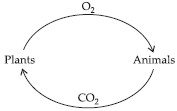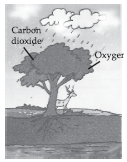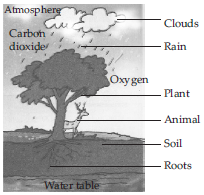Forests-Our Lifeline (Biology) Class 7 - NCERT Questions
Explain how animals dwelling in the forest help it grow and regenerate.
SOLUTION:Various types of animals (herbivores, carnivores) live in a forest and help the forest to grow and regenerate in the following ways:
(i) Animals help in pollination of flowers i.e., transfer of pollen grains from the anther of one flower to the stigma of another flower.
(ii) Animals help in dispersal of seeds of plants to long distances.
(iii) Animal excreta (or droppings) and their dead bodies are acted upon by microbes and are converted into nutrients. These nutrients are released into the soil and are absorbed by plant roots. In this way, animals provide nutrients for plant growth.
Explain how forests prevent floods.
SOLUTION:Forests act as natural absorbers of rainwater and allow it to seep in the ground. In the absence of trees, rainwater would hit the ground directly resulting in floods. However, in a forest, raindrops do not hit the forest floor directly. The canopy layer of the forest intercepts the flow of raindrops so that most of the rain water comes down through the branches, stems and leaves of the trees. Thus, water does not collect and stagnate on the forest floor. This prevents flooding.
Q 3.What are decomposers? Name any two of them. What do they do in the forest?
SOLUTION:Decomposers are the microorganisms which feed on dead remains of plants and animals and convert it into nutrient rich humus. Bacteria and fungi are the examples of decomposers. Decomposers carry out the important process of recycling of nutrients in a forest. They decompose (break down) the dead plant and animal matter into nutrients which are released back into the soil.
Q 4.Explain the role of forest in maintaining the balance between oxygen and carbon dioxide in the atmosphere.
SOLUTION:Plants consume carbon dioxide released by the animals and release oxygen in the process of photosynthesis. They help in providing oxygen to animals for respiration. They purify air by absorbing CO2 and releasing O2. In this way, forests help in maintaining the balance between oxygen and carbon dioxide in the atmosphere.

Explain why there is no waste in a forest.
SOLUTION:Forests work as a self sustaining system in nature. Whatever is produced in the forest is utilized by different components of the forest and is naturally recycled. All animals (whether herbivores or carnivores) depend ultimately on plants for food. Herbivores eat plants.
Carnivores eat herbivores. When plants and animals die, their dead remains are decomposed by microorganisms (bacteria and fungi) into nutrients, which are released back into soil. From the soil, these nutrients are absorbed by the roots of living plants. This is called as recycling of nutrients due to which nothing goes waste in a forest.
List five products we get from forest.
SOLUTION:Five products obtained from forests are fruits, timber, latex, resins and spices.
Q 7.Fill in the blanks :
(A) The insects, butterflies, honeybees and birds help flowering plants in ________.
(B) A forest is a purifier of ________.
(C) Herbs form the ________ layer in the forest.
(D) The decaying leaves and animal droppings in a forest enrich the ________.
(A) pollination (B) air (C) lowest (D) soil
Q 8.Why should we worry about the conditions and issues related to forests far from us?
SOLUTION:Forests are an important renewable resource. We should be concerned about the issues related to forests due to the following reasons:
(i) Forests help in purifying the air. A decrease in forest area would result in more CO2 and other harmful gases in the atmosphere. Increased CO2 would result in global warming.
(ii) Forests provide food and shelter to the animals. When forests are adversely affected, the habitats of wild animals are also adversely affected.
(iii) Destruction of forests would result in soil erosion, desertification, droughts and floods.
(iv) Forests provide us a large number of useful products including wood, fuel, medicines etc. We will be deprived of these products in the absence of forests.
Explain why there is a need of variety of animals and plants in a forest.
SOLUTION:A variety of plants and animals in a forest, helps it to grow and regenerate. Greater variety of plants means more food for the herbivores. An increase in the number of herbivores means more food for carnivores. Decomposers help to maintain the supply of nutrients to the soil and to the growing plants. This wide variety makes the forest a dynamic living entity.
Q 10.In the given figure, the artist has forgotten to put the labels and directions on the arrows. Mark the directions on the arrows and label the diagram using the following labels:
clouds, rain, atmosphere, carbon dioxide, oxygen, plants, animals, soil, roots, water table.

The labelled figure is as follows:

Which of the following is not a forest product?
(i) Gum (ii) Plywood (iii) Sealing wax (iv) Kerosene
(iv) Kerosene
Q 12.Which of the following statements is not correct?
(i) Forests protect the soil from erosion.
(ii) Plants and animals in a forest are not dependent on one another.
(iii) Forests influence the climate and water cycle.
(iv) Soil helps forests to grow and regenerate.
Statement (ii) is incorrect. Plants and animals in a forest are dependent on each other for their growth and survival. Plants provide oxygen, food and shelter to animals whereas animals provide CO2 to plants for photosynthesis and help in their seed dispersal to distant places.
Q 13.Microorganisms act upon the dead plants to produce
(i) sand (ii) mushrooms (iii) humus (iv) wood.
(iii) humus